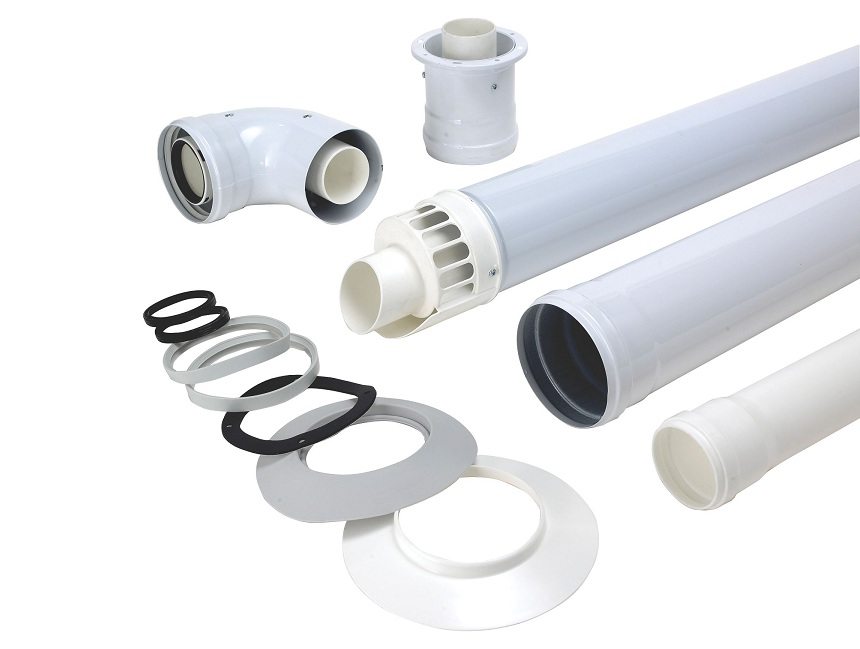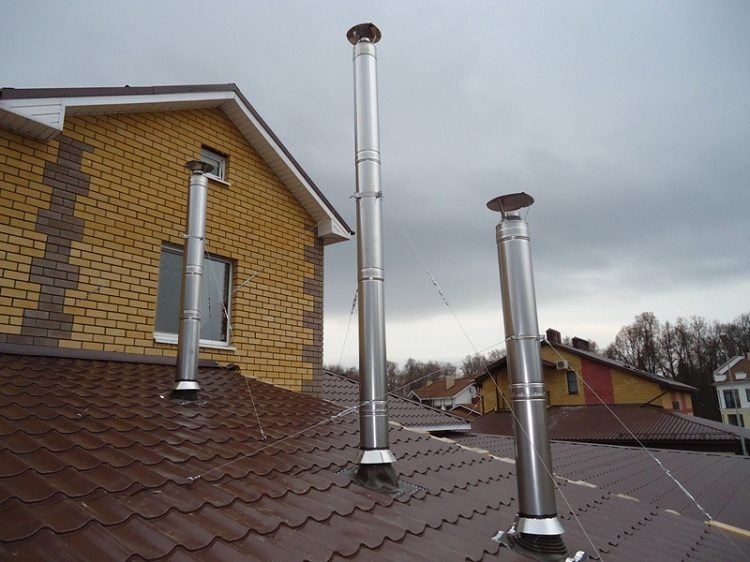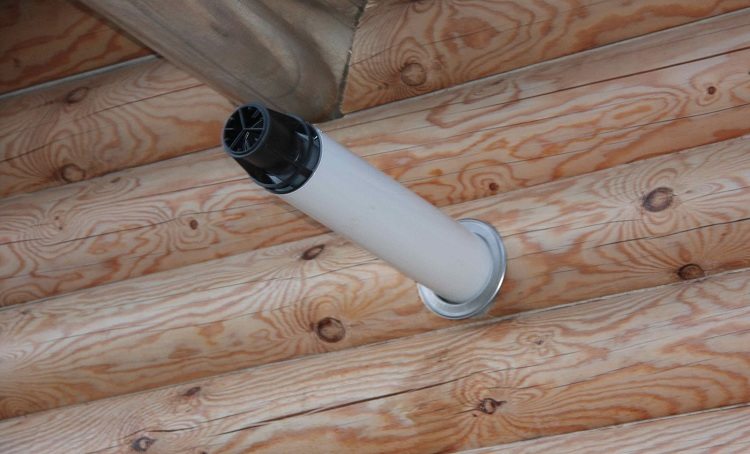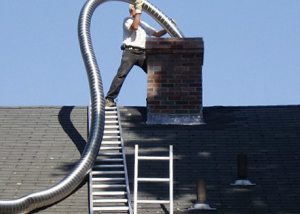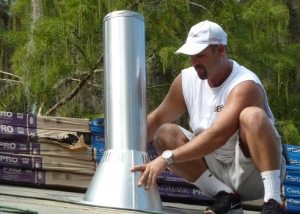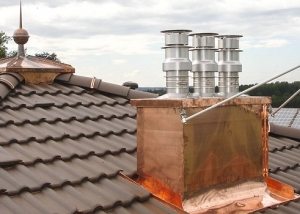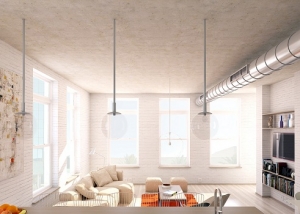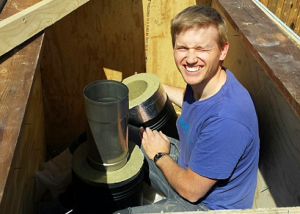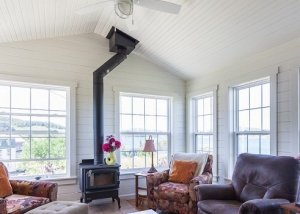Many ideas on how to heat a room are embodied in various inventions and technologies that are successfully applied at this time. Evidence of this is the emergence of modern autonomous heating systems, which are becoming more practical, economical mini-factories for the production of heat. The system can operate on many types of fuel, during the combustion of which combustion products that are hazardous to life are released. Therefore, the efficiency of the heating boiler also depends on the efficiency of smoke removal outside the room.
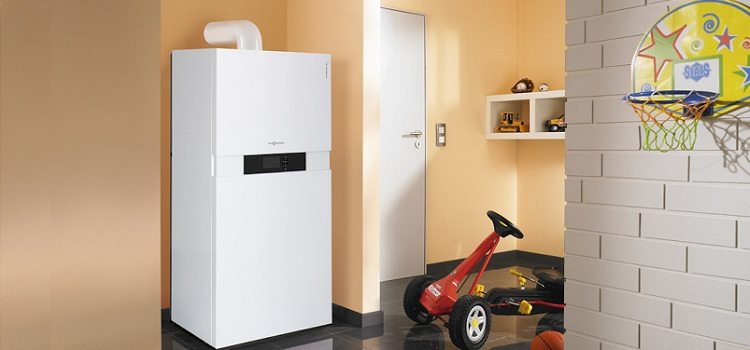
Coaxial chimney is a modern system for the removal of combustion products of heating boilers, including gas
Content
Coaxial chimneys for boilers
Combustion is supported by air flow. During the operation of the furnace, air enters the furnace from the room, burning a large amount of oxygen inside, the room has to be ventilated, and valuable heat is lost. This is how most households with a classic individual heating system are heated. Now they began to use alternative heating systems with a closed combustion chamber (gas boiler, convector, radiator). In this case, the air supply and the simultaneous exhaust are carried out by a coaxial pipe for a gas boiler - a technologically non-standard solution that has recently appeared, but is already in demand. The progressiveness of the solution lies in the fact that air enters the boiler from the street through the same pipe, which removes the combustion products. Two functions are performed by one pipe due to the peculiarities of its design.
And the feature is this: a coaxial chimney consists of two pipes. A pipe of a smaller diameter (60-110 mm) is located in a pipe of a larger diameter (100-160 mm) so that they do not touch one another (have one axis) through jumpers along the entire length, which give the structure strength. The inner pipe is a chimney, and the outer one is needed for air flow. The circulation of air masses of different temperatures creates a thrust ordering their movement. The air in the room is not involved in the process of burning gas in the boiler, the microclimate and heat are retained.
Important! Coaxial chimneys are intended only for devices with a closed combustion chamber.
Production material - steel (stainless, galvanized, enameled). The length of the coaxial chimney should not exceed 3 m to prevent swirling of the air flow. In the instructions for the gas boiler, you can also find information on limiting the length of the chimney, which must be taken into account, since the uninterrupted operation of the device depends on this. Shortened or extended bends will not provide normal natural traction without electric blowing.
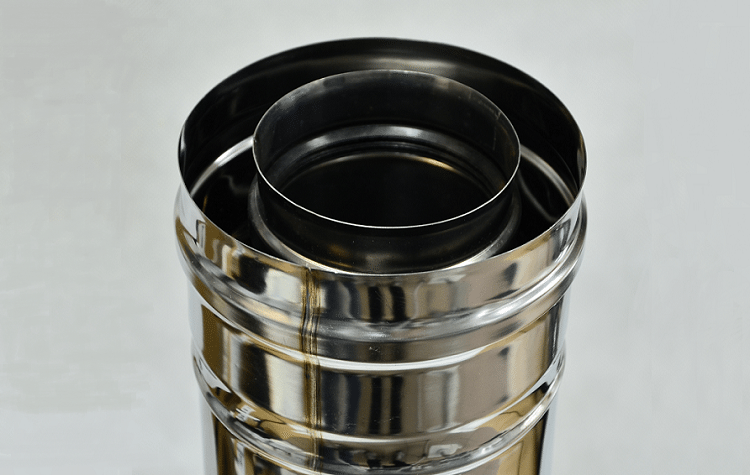
Coaxial chimney consists of two pipes - a smaller part is inserted into the workpiece of a larger diameter
The whole structure is quite compact, the required kit includes:
- coaxial pipe (there may be several);
- coaxial angle (elbow, bend) 45, 90 degrees;
- tee;
- adapter for connecting to a gas boiler;
- cleaning (part of the system for preventive maintenance);
- condensate collector;
- chimney tip (weather protection);
- clamp - an element of fastening;
- flange wall mount;
- o-rings.
The design can be supplemented by details of the extension of the chimney - coaxial pipes 0.5-1 m long.
Another distinctive feature of the coaxial chimney from the usual one is the horizontal exit of the pipe outside the room, which significantly saves space and gives more options for choosing the location of the boiler. A pipe connected to the boiler (mainly with forced circulation of air masses) is discharged through the wall in a horizontal plane, reducing the consumption of expensive chimney parts. If there is no possibility to remove the chimney through the wall (near the window, the facade is broken), a vertical outlet through the roof is provided. The vertical position can also be mounted on the outside of the wall of the building, a coaxial chimney connected to the boiler is discharged through the wall and up.
The coaxial chimney is designed to serve both one boiler (individual) and several (collective). The individual is lined up in one line and does not have branching, the collective consists of separate branches of the coaxial system, displayed on each floor of a multi-storey building and connected to a single pipe to output combustion products.
In a multi-storey building, a chimney is located vertically. It can be external (along the facade of the building) and internal (house mines, canals). The external chimney has constant access for repair and maintenance, but it spoils the exterior of the building.
Positive aspects of a coaxial chimney
We can name such features of such channels:
- significantly increases boiler productivity: fuel is completely burned by the circulation of warm air currents. Cold air from the street, passing through the chimney, heats up, while the heated smoke goes outside, thereby maintaining the temperature balance in the chimney. This advantage also speaks about the environmental friendliness of the entire heating installation (emissions are reduced);
- fireproof. The outer surface of the coaxial pipe does not reach the ignition temperature (smoldering) of adjacent materials. To enhance safety, they resort to pipe insulation in contact with wooden planes, however, not as solid as in the case of a conventional metal chimney. Unburned particles do not accumulate on the inner surface of the chimney, this eliminates ignition inside the pipe;
- in the room where the boiler is installed, comfortable indicators of temperature, humidity are stored, there are no harmful impurities in the air due to closed air exchange in the equipment through a coaxial pipe;
- the operation of a gas boiler with a coaxial chimney is economical, as fuel consumption is reduced, there is no heat loss;
- does not take a lot of space in the room (especially true for small kitchens);
- simple installation, various sizes of coaxial pipes and auxiliary parts facilitate their selection for boilers of any capacity;
- the inner steel pipe is resistant to acids (combustion products in combination with condensate form destructive acids), withstands temperatures up to 500aboutC, the service life in compliance with all installation standards is 25-30 years.
The negative side of the coaxial chimney:
- the coaxial pipe for the gas boiler is not protected from the formation of condensate, and subsequently icing at a temperature of -15aboutWITH;
- in systems with forced air circulation, the operation of the chimney is disrupted in the event of a frequent blackout or power surges;
- high cost, expensive repairs.
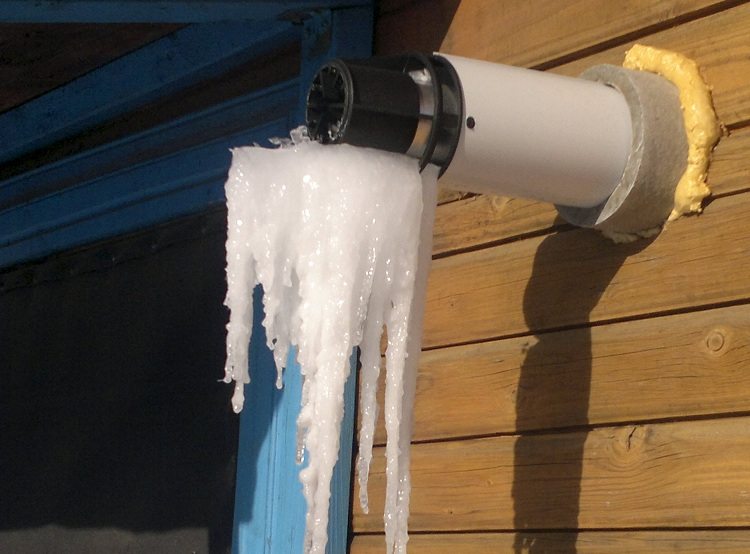
One of the disadvantages of chimneys of this type is icing in the winter, but this is often due to improper installation
Installation of a coaxial pipe of a gas boiler
Preparation for the installation of a coaxial chimney should begin with an introduction to the norms and rules:
For a collective system:
- the chimney must be installed only vertically and rise above the roof at a distance of at least 1.5 m;
- smoke extraction in a single pipe with connection to it of taps from each boiler. Canals should not pass through living quarters;
- the basement chimney is discharged at a height of at least 2 m from the ground;
- the location of the chimney near windows, doors or balconies is not desirable, although a distance of 1 m from the pipe to the window above it is permissible. Complaints of residents cannot be avoided.
Important! The output of a coaxial chimney into the window pit of the basement and semi-basement is not allowed.
For an individual system:
- a vertical coaxial chimney in a one-story building should rise 0.5 m above the roof ridge;
- the outlet should be 1.5 m above the boiler firebox;
- the discharge channel should not be diametrically smaller than the boiler outlet pipe;
- the distance from the chimney to windows, doors, ventilation openings should be 0.5 m if it is on the side or above them. If under them, then 1 or more meters;
- the height of the horizontal outlet of the chimney above the ground is 2 m;
- the distance from the tip of the flue gas vent with a deflector to the blank wall of a neighboring building is 2 m, to a wall with windows, doors 5 m. Without a deflector 8 m;
- a chimney (diaphragm) of sheet metal, located at a distance of 0.4 m from the tip, will help protect the chimney from the wind constantly blowing against the smoke stream;
- the distance to the gas pipeline is at least 0.2 m.
Coaxial chimneys for gas boilers are suitable for self-assembly. With strict observance of the instructions and safety measures, it will not be difficult to assemble the system. The first step is to determine the location of the heating equipment so that the location of the pipe does not conflict with regulatory restrictions. Then, at the stage of calculating the amount of material, the following installation nuances are taken into account:
- the height of the chimney from the nozzle of the floor gas boiler to the wall opening is at least one meter, from the wall - half a meter;
- the system should not include more than two turning parts;
- the length of the horizontal section should not exceed one meter, vertical five meters. With forced traction, the vertical section of the pipe can not be mounted if it is displayed in the wall;
- horizontally lying pipe give a slope of 3 degrees. towards the boiler (condensing) or from the boiler (normal) preventing the accumulation of condensate;
- the entire length of the smoke exhaust system must not exceed three (five) meters;
- a wall hole for the outlet of the chimney is made with a gap of 10 mm. The hole through flammable materials should have a gap of 50 mm;
- the joint of the chimney parts should be outside the thickness of walls and ceilings;
Important! It is unacceptable to include parts not specifically provided for in the coaxial chimney, or parts of different manufacturers, self-made, with defects. Adhesive bonding and sealants are prohibited.
After the place is determined and the heat unit is installed, mark and drill a hole on the same wall to which it adjoins. Then the coaxial pipe is connected to the gas boiler (outlet pipe) using a clamp with a bolt coupler. All elements of the smoke exhaust system are interconnected by clamps according to the design plan, fixed vertically on the wall with special brackets. The horizontal section is installed in the hole. The gap between the wall hole and the pipe is filled with a non-combustible heat insulator, it is isolated from the street with construction foam. To make everything look aesthetically pleasing, the holes are closed with decorative overlays. The horizontal and vertical parts are connected by special turning parts (corner, elbow).Joints of elements are complemented by heat-resistant rubber seals. The head of the vertical chimney must be protected from ingress of rain.
If a coaxial chimney for a gas boiler passes through combustible material (wooden walls, ceilings) in places of contact, protective covers are used, pieces of asbestos-cement pipe in combination with a heat insulator. It is recommended to increase the outdoor section of the pipe to 0.6 m in order to avoid contact of wooden walls with hot smoke. Although the chimneys for gas boilers are not coaxial fire hazard, their surface does not reach the ignition temperature, you should still resort to these fire protection measures.
Installation is always carried out according to the manufacturer's instructions in compliance with the rules and regulations. After completion of installation work, the system is checked for tight joints, traction.
Solving the problem of condensation formation and freezing
The main problem that the owner of the coaxial chimney will have to face is the condensate that forms at sub-zero outside temperatures. The presence in the design of the smoke exhaust tank to collect condensation moisture will prevent it from entering the boiler and thereby disrupt its operation. The slope of the pipe is 2-3 degrees. towards the boiler will allow moisture to drain through the tee into the steam trap.
Important! It is forbidden to discharge condensate into the ground, since it is a dangerous acid-containing substance.
Thermal insulation of the outer surface of the chimney of any type is considered mandatory, but it does not solve the problem in a coaxial chimney due to the design features and the principle of operation of the system. The issue of warming the coaxial chimney has caused controversy, initially such a measure was not provided for by the manufacturer. It is carried out experimentally and does not give a definite effect. An even bigger problem is the condensate freezing - icing of the pipe head or the formation of ice plugs inside the chimney. If the bias was made from the boiler (so that the condensate does not stagnate inside and drain out), then the solution may be to shorten the inner pipe. There is a special nozzle - a module for protection against icing.
When designing a system, it is important to carry out the correct calculation. So on the length of the chimney, what will be the temperature at the outlet. Exceeding the length will result in cooling of the flue stream and freezing of the condensate formed.
The problem with condensation can be caused by the installation of a large-capacity heat generating unit, where the chimney cannot provide normal draft, which will increase the production of moisture. Coaxial chimney is suitable for boilers up to 40 kW. Therefore, often the smoke exhaust system comes complete with a boiler, and there is no need to doubt their compliance. A short horizontal outlet of the pipe from the wall can cause condensation to get on the brickwork, which should be avoided, as this will lead to the destruction of the wall (condensate is an aggressive chemical environment with accumulation of combustion products).
Although the operation of the coaxial chimney for a gas boiler is designed for a mild climate, correctly performed calculations, observing the rules, norms and instructions will allow you to quickly and efficiently assemble a system with high efficiency indicators that will last a long period of time.
